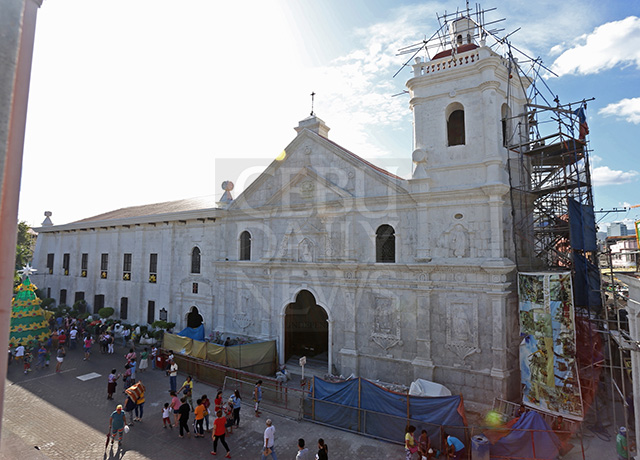
Not full restoration but a reconstructed belfry with concrete walls and foundation is ready for the Sto. Nino fiesta whose novena Masses start on Thursday. (CDN PHOTO/JUNJIE MENDOZA)
When people gaze at the centuries-old Basilica del Sto. Niño at the start of the Fiesta Señor novena on Thursday, they will see a complete church structure.
After six months of construction, the bell tower was rebuilt although finishing touches are still being applied.
The coral stones from the old belfry that collapsed during the 7.2-magnitude earthquake on Oct. 15, 2013 were no longer returned.
Instead, a new concrete foundation was poured with concrete walls and beams clad with coral stones to resemble the old belfry.
The reconstruction was finished in time for this year’s religious feast which begins on Thursday with a dawn procession from Fuente Osmeña to the church.
Work was also hastened for the 51st International Eucharistic Congress to be held Jan. 24 to 31 in Cebu City.
“I’m so happy. I’m lost for words. It took over two years before we have the bell tower back. All this is God’s work,” said Fr. Jonas Mejares.
The church’s main entrance door, which was closed during repair work, will be re-opened on Thursday as well.
“I feel relieved. Every now and then, people would approach and ask me why it took us so long to rebuild the bell tower. I understand their sentiment. They just love the church so much,” Mejares said.
The reconstruction was supervised by the National Historical Comission of the Philippines (NHCP) which allocated P13,670,672.90 for the project.
Work started in July 2015 by 401 Development and Construction Corporation, which won the bidding.
The same contractor restored churches of Santa Barbara and Miag-ao in Iloilo. It also undertook projects for the National Museum and the San Agustin Church in Intramuros, Manila.
Mejares said workers spent the Christmas break at the basilica to finish the bell tower on time.
Not all seven bells will be reinstalled, though.
“The biggest bell will no longer appear on the tower. We have to reduce the belfry’s weight because it poses risks during earthquakes . Hence, only the six smaller bells shall be reinstalled there,” Mejares explained.
The biggest bell will be placed somewhere inside the basilica compound to remind people about the 2013 earthquake.
The reconstruction was led by Engr. Carlos Villaraza, president of the Association of Structural Engineers of the Philippines.
Fr. Harold Rentoria, chairman of the Commission on Cultural Heritage of the Augustinian Fathers, said it took two years because “we had to review and review.”
“Restoration takes a lot of time. Experts, during a conference, were telling us we can’t have a particular standards or one way of doing it. We have to study it. We have to see the distintness of the structure,” he told CDN.
Rentoria denied that work was unduly rushed to finish before this year’s feast and the IEC.
“There are always pressures (to finish it). But it should not be the reason to hasten a project. I trust NHCP. They had to use new technology combined with the traditional way of restoring the bell tower,” he said.
The old bell tower that was destroyed by the 2013 earthquake wasn’t the original structure built by the Spaniards.
“There were some renovation of the belfry sometime in the 60s and even earlier. It was not exactly as it was before.
If you look at it, the lantern (the topmost part of the bell tower) was made of cement. And we saw steel bars. Spaniards didn’t use cement and steel bars,” he explained.